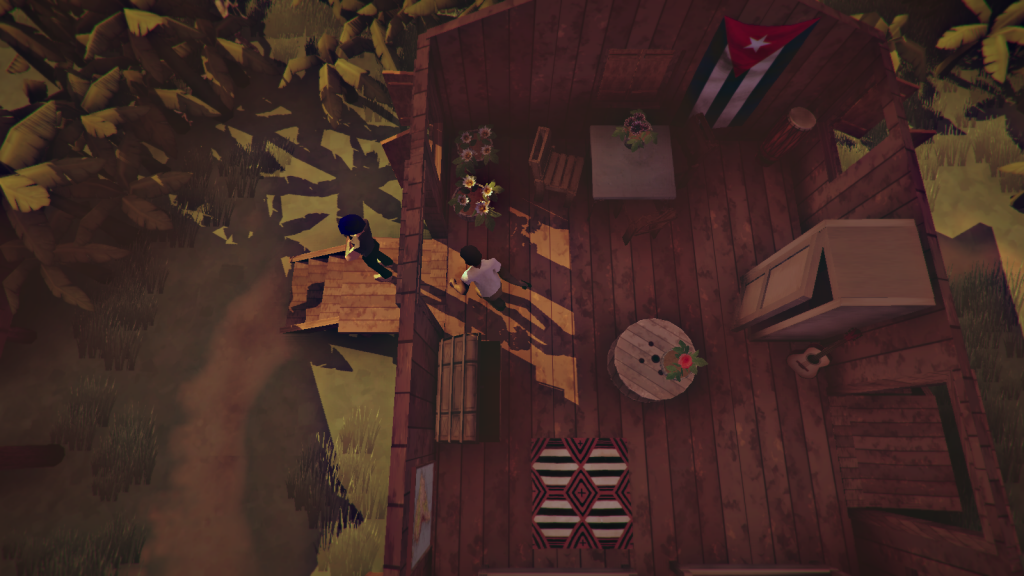You can beat The Church In The Darkness in under an hour if you know what you’re doing and understand basic video game mechanics. Within that structure however, is a vastly complicated game that’s deeper than you initially see. TCITD appears to be a kiddie pool, twelve inches or so of water, fun but simple. Once you step in however, you realize there’s a deep end brimming with content.
Made by Paranoid Productions and released by publisher Fellow Traveler, TCITD follows the story of a Jonestown style cult in South America. As an investigator you’re tasked with finding your nephew who recently joined the group and getting your nephew out. Along the way you make several far-reaching decisions that can drastically change your play through and give you one of nineteen different endings.

Stealth Encouraged
I decided my first play through I’d do a no-kill run. No kills typically can bring about the best endings in video games like this one. Also, the shooting mechanics of the game are extremely basic and at times frustrating. I felt the developer pushing me toward stealth, so I went along.
From an overhead camera you navigate your character and are shown the vision arcs of the patrolling guards. It’s simple enough to evade them. Within thirty minutes I had found a few cult members willing to speak with me. I had the cult leaders marked on my map and I knew where my nephew was. Time to get him and go. Navigating the map feels especially creepy thanks to the near constant announcements from the cult leaders. They tell their community (via a set of loudspeakers) that they only want to worship in peace. The weapons are just for protection. I find my nephew and order him to follow. He agrees after I show him some evidence that the cult isn’t what it seems. We make it to my extraction point and my no-kill run is complete.
Before the credits you’re shown what happens to the cult. These endings are a direct result of your actions. It turns out I saved my nephew successfully but the cult leader ordered mass suicide. So I had technically “won” but not really.

Additional Playthroughs Open Up Paths
The end of the credits were the real surprise for me, and the reason I kept playing this game for hours. Before I started my next “run” the game told me that a new character would be in the cult. Additionally I’d have access to a new tool, the “Tranq Gun” that can shoot sleep darts.
That one moment, at the end of my first run, was the hook. I was now invested more than I realized.
I dropped in again but noticed my entry point was different. It was the exact same map but all the character locations were changed and many guards now featured different patrol patterns. Much of the camp is procedure-generated and gives you new challenges while keeping the same overall world map.
At this point I realized the best ending clearly saves your nephew and also saves the town. I also realized the best possible ending might require the death of the cult leaders. After all, I wanted to avoid the mass suicide of my previous run.
A Game Made With Intention
Richard Rouse III, the designer of the game, has had a cult fascination since he was young. In particular The Church in the Darkness has strong callbacks to Jonestown and also a cult called The Source Family which came to prominence in Hollywood in the 1960’s.
Rouse is clearly wanting to encourage thought more than he’s wanting to give specific answers. It’s an angle I respect a lot. Cults are real and shouldn’t be pushed to the back of our minds. When I was sneaking around his gaming environment I found myself wondering what I’d actually do in a similar situation.
As you experience multiple play throughs you’ll notice the cult leaders also have significant changes to their personalities. Depending on which personality you’re dealing with, killing the cult’s leader can be an easier decision or a tough one.

Understanding Negative Reviews
The mixed reactions the game is currently receiving virtually all center around game play. Yes, there are mechanics that feel “clunky” and in any procedure generated game there are moments that feel wildly easy and other moments that feel impossible.
I give this game a highly positive review because I felt myself viewing the game through Rouse’s intentions. This game might feel aged in the hands of current gen gamers, but it would be a brilliant tool for a Sociology professor.
As I mentioned the game can be beaten very quickly. The reason for that is Rouse wants you to push deeper and see the other kinds of endings. He wants you to explore your own reactions, look internally as you play through the decision making process. That is the main reason I recommend The Church In the Darkness, not because of what it says about society, but because of what it tells yourself about you.
Nathan is the co-host of the Splash Damage Bros. Podcast. He believes the Splash Damage Bros. are the only real cult you should ever consider. He can be found @thenatejc and @splashdamagebro on Twitter.



